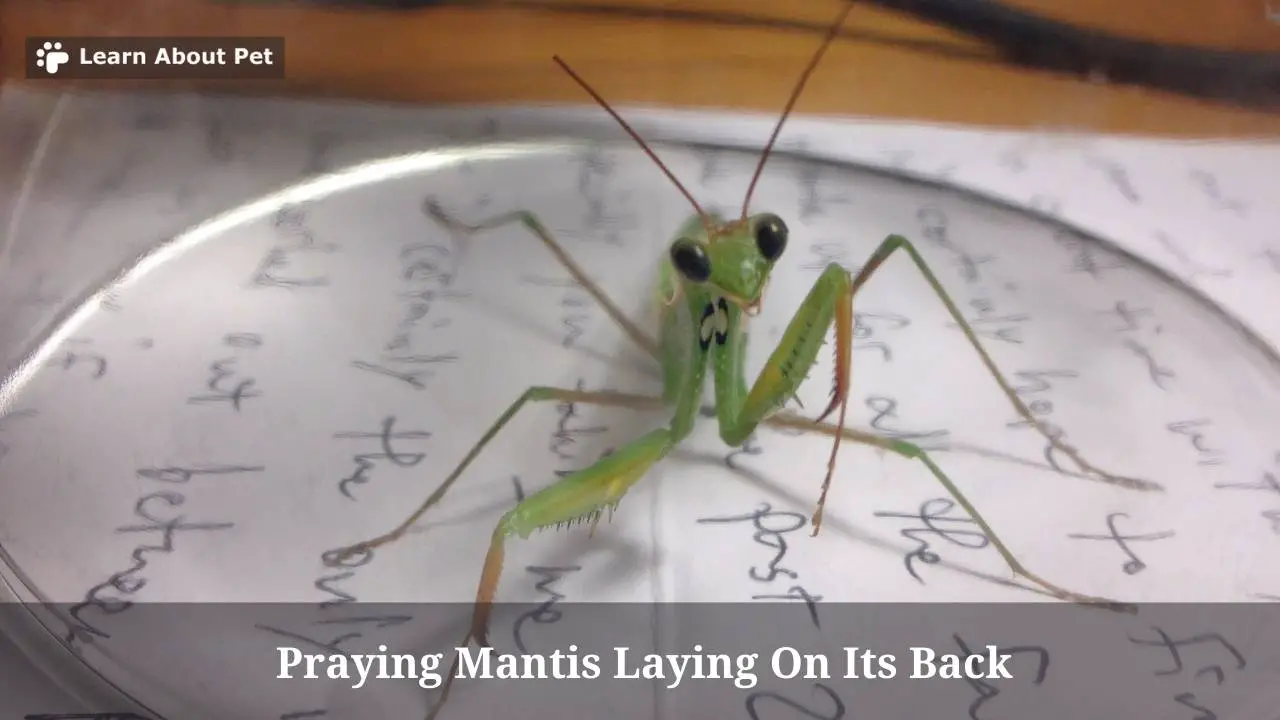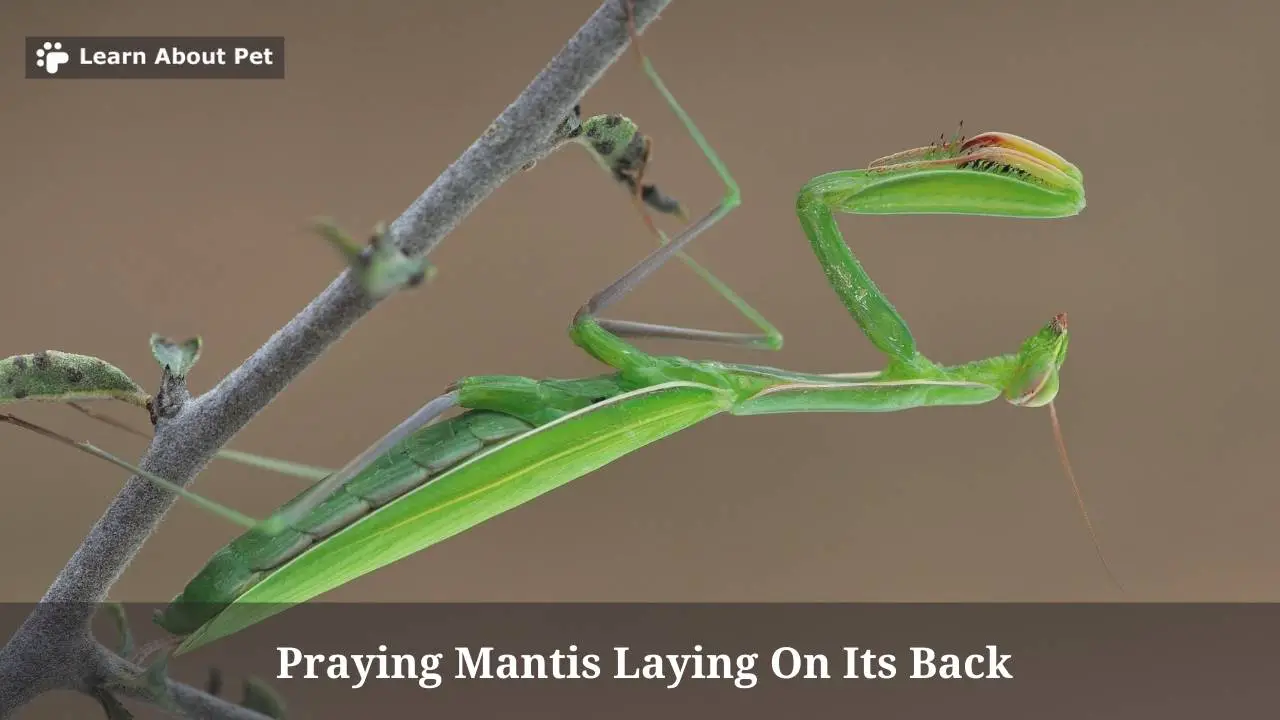It can be rather disconcerting to discover your pet praying mantis lying on its back. Once you observe your mantis in that posture, you will want to know whether it is normal, and what it means. Read on, for answers.
If you find a praying mantis laying on its back, it may be molting. There are also cases in which praying mantises that are sick or dying lie on their backs.
Thus such lying on the back is one of the praying mantis molting symptoms. It can also be one of the praying mantis dying symptoms.

Is It Usual For Praying Mantis To Lie On Its Back?
As noted earlier, one of the common reasons for a praying mantis laying down on its back is molting. And the molting is something all praying mantises do, as they grow.
Thus it is quite common (and usual) to find a praying mantis lying on its back for molting purposes.
A praying mantis may also lay on its back if it is sick or dying.
Some praying mantis behaviors are quite hard to make sense of: an example being, say, that of a praying mantis laying eggs without mating.
But a behavior like this one – in which the mantis lies on its back for molting purposes, is quite common and easy to make sense of.
However, if it is the first time you are encountering it, the sight of a mantis laying on its back can be quite shocking. It will instantly get you wondering, why is my praying mantis laying down on its back?
This posture can actually create the impression that the mantis is ‘hanging upside down’. And that gets the owner wondering, why does my praying mantis hang upside down? Is my praying mantis sick? Or what could be wrong?
Ultimately though, we see that a mantis laying on its back (especially for molting purposes) is quite usual.
Why Is My Praying Mantis Laying On Its Back?
If a mantis is laying on its back, it could be molting. Otherwise that mantis could be sick or dying.
If you research on the mantis molting signs, you will see that laying on the back is one of them. So the mantises lie upside down while molting.
On the other hand, if you research on what happens when a praying mantis dies, you will see that it often lies upside down. So it lays on its back.
Indeed, with regard to the how do praying mantis die question, laying on the back is one of the first things…
Ultimately, we learn that the most common (and most benign) reason for a mantis laying on its back is molting.
Once you rule the possibility of molting out, you next consider illness. For instance if you find a praying mantis twitching but laying on its back, this may be due to illness.
Mark you, the illness in question could include one of a physiological nature – like dehydration or even starvation.
Actually, with regard to how can you tell if a praying mantis is dehydrated (for severe dehydration), one of the key signs could turn out to be that of the mantis laying on its back.
If the mantis’ laying on its back is not due to molting or illness, it may mean that the mantis is dying.

But note that differentiating a molting mantis from a dying mantis is not always that easy. Indeed, that question (is my mantis molting or dying) is a very frequently asked one.
Thus the mantis in question may be molting, sick or dying.
Can The Praying Mantis That Is Laying On Its Back Be Asleep?
Here, we need to start by asking ourselves, do praying mantis sleep upside down? How do you know when a praying mantis is sleeping anyway?
The true position is that, for ordinary sleep, mantises normally don’t adopt an upside down posture. So you usually won’t find a mantis laying on its back simply for sleeping purposes.
The mantis that is laying on its back is more likely to be either molting, sick or dying.
There are of course those who try to ascribe deeper meanings to mantis behaviors. So that is how questions like the one on what does it mean when a praying mantis crawls on you come up…
As for a mantis laying on its back, the objective reasons would be either molting, being ill or dying. One can, however, go ahead to ascribe a wide range of other subjective possible reasons for the mantis being in that posture.
Just remember, in objective terms, when you find a mantis laying on its back, it is likely to be molting, sick or dying.
My Praying Mantis Is Laying On Its Back – What To Do?
You first need to try to figure out what the reason for the mantis laying on its back could be.
If it is due to molting, just give it time (without disturbing it) to complete the molting process. You can consider improving humidity levels, to make the molting process smoother.
If it is due to sickness, offer the mantis the necessary support to increase chances of recovery.
And if the mantis is dying, ask yourself whether what seems to be killing it is reversible or not. If it is reversible, offer the necessary support, to enhance chances of the mantis recovering.
Final Verdict – Praying Mantis Laying On Its Back
A praying mantis that is laying on its back could be molting, sick or dying.
If the mantis is lying on its back on account of molting, chances are that it will be upright again once the molting process is over. But you need to know that molting is hard for mantises, and some fail to go through it successfully.
If the mantis is laying on its back on account of illness (or because it is dying), it may go ahead to recover. Or it may fail to recover and end up losing its life.
The best you can do is offer such a mantis that is laying on its back the necessary supportive care. For instance, if it seems to be molting, you can improve the humidity condition, to ease the molting process.

Sometimes, if the mantis was laying on its back due to sickness or because it was dying, it may unfortunately just end up dying.
In that case, you can perhaps organize some sort of burial for it, to get closure (if it was a pet mantis). Then consider getting a replacement for it, if you found keeping a pet mantis to be fun.
As a pet lover, make sure to learn about pet more and give your pet mantis a good and comfortable life!

Welcome to Learn About Pet. My name is Rajkumar Ravichandran and I love all pets, travel, and amazing food. I write about my passion and personal experience caring for multiple pets in this blog! ❤️
Post Disclaimer
DISCLAIMER: THIS BLOG OR WEBSITE, "Learn About Pet", DOES NOT PROVIDE YOU WITH MEDICAL ADVICE AND IS NOT A SUBSTITUTE FOR MEDICAL ADVICE. ALWAYS GET IN TOUCH WITH YOUR PERSONAL VETERINARIAN AND USE INFORMATION HERE AS GENERAL ADVICE.
The information, including but not limited to, text, graphics, images and other material contained on this website are for informational purposes only. No material on this site is intended to be a substitute for professional veterinary advice, food recommendation, diagnosis, or treatment. Always seek the advice of your veterinarian or other qualified health care provider with any questions you may have regarding a medical condition or for pet food related questions.







